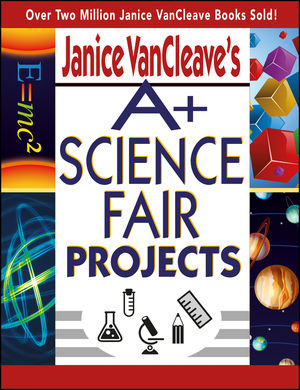Janice VanCleave's A+ Science Fair ProjectsISBN: 978-0-471-33102-5
Paperback
164 pages
August 2003, Jossey-Bass
 This is a Print-on-Demand title. It will be printed specifically to fill your order. Please allow an additional 10-15 days delivery time. The book is not returnable.
|
||||||
How to Use This Book.
I. A GUIDE TO SCIENCE FAIR PROJECTS.
1. The Scientific Method.
2. Topic Research.
3. Categories.
4. Project Research.
5. Project Overview.
6. Experimental Data.
7. Project Summaries.
8. The Display.
9. Presentation and Evaluation.
II. 35 A+ SCIENCE FAIR PROJECT IDEAS.
Astronomy.
1. Solar System Scale: Miniature Model (Planetology).
2. Angular Separation: Angular Distance between Celestial Bodies(Astronometry).
3. Orbital Period: Time of Revolution (Celestial Mechanics).
4. Artificial Satellites: Man-made Orbiters (Astronautics).
5. Apparent Magnitude: Apparent Star Brightness(Astrophysics).
6. Sunspots: Cooler Surface Regions (Heliology).
7. Galilean Satellites: Jupiter's Largest Moons (PlanetarySatellite Science).
8. Meteors: Streaks of Light in the Sky (Meteoritics).
Biology.
9. Meristematic Region: Growth Zone(Botany--Morphology).
10. Seed Parts: Exterior and Interior(Botany--Anatomy).
11. Autotrophs: Food Builders (Botany--Physiology).
12. Aquatic Respiration: Breathing Rate of Goldfish(Zoology--Anatomy).
13. Operant Conditioning: The "Aha!" Response(Zoology--Behaviorism).
14. Ecosystem: Interactions (Ecology).
15. Preservatives: Food Additives (Microbiology).
Chemistry.
16. The Best Plant Food: Nutrient Differences in Soils(Agricultural Chemistry).
17. Acid-Base Indicators: Color Changers (InorganicChemistry).
18. Enzymes: Chemical Controllers (Biochemistry).
19. Triglycerides: Saturated and Unsaturated (OrganicChemistry).
20. Vitamin C Content: Analysis of Food by Titration (AnalyticalChemistry).
21. Viscosity: A Difference in Stickiness (PhysicalChemistry).
Earth Science.
22. The Hydrologic Cycle: The Movement of Water from Place toPlace (Physical Geology--Hydrology).
23. Minerals: Distinguishing Physical Characteristics ofMinerals (Physical Geology--Mineralogy).
24. The Rock Cycle: Processes That Change One Rock Type intoAnother (Physical Geology--Petrology).
25. Soil Texture: Effects of Regolith Size (PhysicalGeology--Soil Science).
26. Topography: Highs and Lows of the Earth's Surface(Physical Geography--Topography).
27. The Greenhouse Effect: Heat Transfer in the Atmosphere(Meteorology).
28. Soundings: Mapping a Profile of the Ocean Floor(Oceanography).
Physics.
29. Resonance: Sympathetic Vibration (Acoustics).
30. Thermal Conduction: Transfer of Vibrational Energy(Thermodynamics).
31. Static Electricity: Stationary Charges (Elementary ParticlePhysics).
32. Electromagnetism: Magnetism from Electricity(Electrodynamics).
33. Static Fluids: Fluids at Rest (Fluid Dynamics).
34. Newton's Third Law of Motion: Action-Reaction(Mechanics).
35. Polarization: Vibrations in One Direction (Optics).
Appendix 1: Random Error of Measurement.
Appendix 2: Relative Error: Percentage Error.
Appendix 3: Planet Facts and Figures.
Appendix 4: Random Sampling in an Open Ecosystem.
Appendix 5: Cross-Staff.
Appendix 6: Preparing Test Solutions.
Appendix 7: Manometer.
Appendix 8: Science Project and Experiment Books.
Appendix 9: Sources of Scientific Supplies.
Glossary.
Index.
I. A GUIDE TO SCIENCE FAIR PROJECTS.
1. The Scientific Method.
2. Topic Research.
3. Categories.
4. Project Research.
5. Project Overview.
6. Experimental Data.
7. Project Summaries.
8. The Display.
9. Presentation and Evaluation.
II. 35 A+ SCIENCE FAIR PROJECT IDEAS.
Astronomy.
1. Solar System Scale: Miniature Model (Planetology).
2. Angular Separation: Angular Distance between Celestial Bodies(Astronometry).
3. Orbital Period: Time of Revolution (Celestial Mechanics).
4. Artificial Satellites: Man-made Orbiters (Astronautics).
5. Apparent Magnitude: Apparent Star Brightness(Astrophysics).
6. Sunspots: Cooler Surface Regions (Heliology).
7. Galilean Satellites: Jupiter's Largest Moons (PlanetarySatellite Science).
8. Meteors: Streaks of Light in the Sky (Meteoritics).
Biology.
9. Meristematic Region: Growth Zone(Botany--Morphology).
10. Seed Parts: Exterior and Interior(Botany--Anatomy).
11. Autotrophs: Food Builders (Botany--Physiology).
12. Aquatic Respiration: Breathing Rate of Goldfish(Zoology--Anatomy).
13. Operant Conditioning: The "Aha!" Response(Zoology--Behaviorism).
14. Ecosystem: Interactions (Ecology).
15. Preservatives: Food Additives (Microbiology).
Chemistry.
16. The Best Plant Food: Nutrient Differences in Soils(Agricultural Chemistry).
17. Acid-Base Indicators: Color Changers (InorganicChemistry).
18. Enzymes: Chemical Controllers (Biochemistry).
19. Triglycerides: Saturated and Unsaturated (OrganicChemistry).
20. Vitamin C Content: Analysis of Food by Titration (AnalyticalChemistry).
21. Viscosity: A Difference in Stickiness (PhysicalChemistry).
Earth Science.
22. The Hydrologic Cycle: The Movement of Water from Place toPlace (Physical Geology--Hydrology).
23. Minerals: Distinguishing Physical Characteristics ofMinerals (Physical Geology--Mineralogy).
24. The Rock Cycle: Processes That Change One Rock Type intoAnother (Physical Geology--Petrology).
25. Soil Texture: Effects of Regolith Size (PhysicalGeology--Soil Science).
26. Topography: Highs and Lows of the Earth's Surface(Physical Geography--Topography).
27. The Greenhouse Effect: Heat Transfer in the Atmosphere(Meteorology).
28. Soundings: Mapping a Profile of the Ocean Floor(Oceanography).
Physics.
29. Resonance: Sympathetic Vibration (Acoustics).
30. Thermal Conduction: Transfer of Vibrational Energy(Thermodynamics).
31. Static Electricity: Stationary Charges (Elementary ParticlePhysics).
32. Electromagnetism: Magnetism from Electricity(Electrodynamics).
33. Static Fluids: Fluids at Rest (Fluid Dynamics).
34. Newton's Third Law of Motion: Action-Reaction(Mechanics).
35. Polarization: Vibrations in One Direction (Optics).
Appendix 1: Random Error of Measurement.
Appendix 2: Relative Error: Percentage Error.
Appendix 3: Planet Facts and Figures.
Appendix 4: Random Sampling in an Open Ecosystem.
Appendix 5: Cross-Staff.
Appendix 6: Preparing Test Solutions.
Appendix 7: Manometer.
Appendix 8: Science Project and Experiment Books.
Appendix 9: Sources of Scientific Supplies.
Glossary.
Index.



